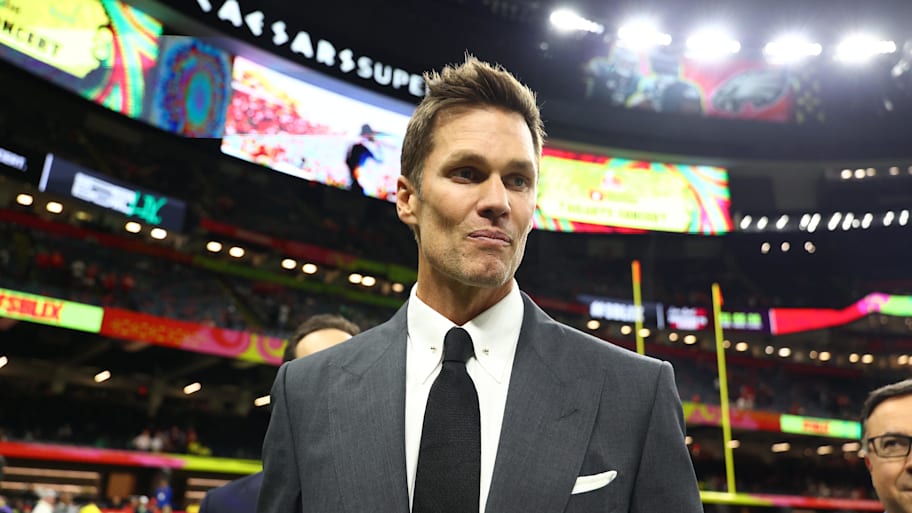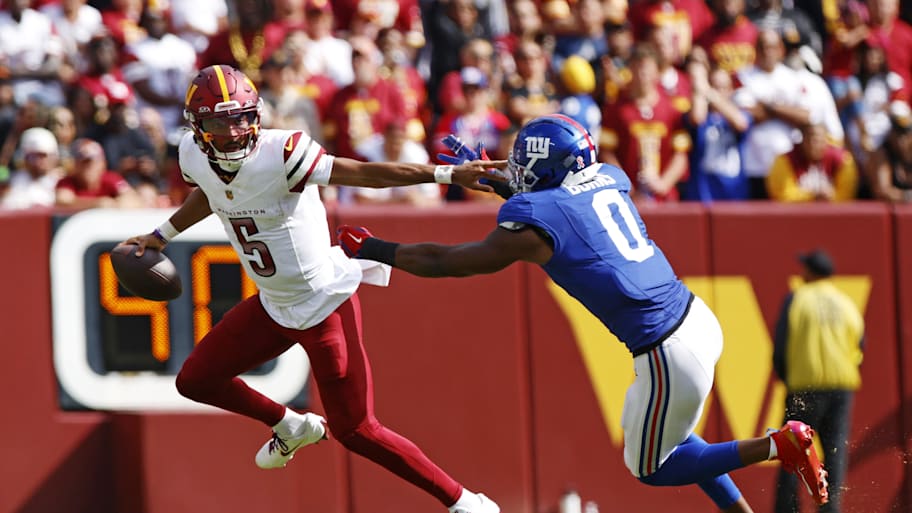
In the second quarter of a Week 1 game between the Commanders and Giants, Fox color commentator Tom Brady mentioned a conversation he had with Giants star defensive tackle Dexter Lawrence during the week in pre-production meetings.
Lawrence, Brady said, brought up how Commanders quarterback Jayden Daniels tends to leave the pocket and it’s difficult to tell where Daniels is going.
“Well, let me tell ya,” Brady said. “He wants to escape to his right.”
“Don’t [the Giants] know that?” Kevin Burkhardt, Fox’s play-by-play man, asked.
“Yeah, you should,” Brady replied. “The execution of it is a whole ’nother issue.”
The second part of this nugget, which Brady almost certainly drew from his observations of Daniels and his own experiences as a quarterback (because Daniels wants to get to the side where he is most comfortable throwing), arrived at the tail end of what I thought was Brady’s finest half of broadcasting. He quickly diagnosed a busted Giants play at the goal line, noting that it was the savvy of linebacker Bobby Wagner tucking underneath an attempted legal pick that blew up the ideal route concept. He also noted how long it was taking Russell Wilson to call a third-and-1 play in the huddle, which, to Brady, meant we could safely rule out the possibility of a quarterback sneak (the Giants ended up running a quarterback sneak, but I still found the observation worth noting). Perhaps the dream of a vintage Tony Romo crossed with Thanos—my original hope for Brady in the booth—was coming to fruition.
I wondered whether the newly lifted broadcast restrictions on Brady—a Raiders minority owner who, while still not allowed to attend team practices, is able to attend production meetings virtually this year—was sharpening his spear. Clearly, it was in the network’s best interest to get Brady to Sunday sounding as buttoned-up as possible, which is why the sensible restrictions were walked back after a hot-and-cold debut season for Brady as a broadcaster in 2024.
Fast-forward eight days later, and Brady was wearing a headset while sitting in the Raiders’ coaching booth during a Las Vegas matchup with the Chargers. ESPN sideline reporter Peter Schrager, with 8:57 remaining in the first quarter, said the following: “[Offensive coordinator] Chip Kelly told us he talks to Brady two to three times per week. They go through film. They go through the game plan. Brady is a luxury for the coaches. Who else has an owner who has actually been there, done that?”
The NFL posted on its official X account: “@TomBrady and @Raiders offensive coordinator Chip Kelly work closely together to help with the game plan [applause emoji].”
The following morning, the post was deleted.
Raiders head coach Pete Carroll said “that’s not accurate,” three times when asked about Schrager’s report at the podium after the game. (Schrager, for the record, has never had a history of erroneous or false reporting, to my knowledge, has been interviewed by me for a story and is a former coworker of mine at NFL Media—so long as we’re laying conflicts of interest out on the table.)
“We have conversations,” Carroll said. “I talk to Tom. Chip talks to Tom regularly. We have a tremendous asset. We all get along well. We respect each other and so we just talk about life and football and whatever it becomes. He has great insight, so we’re lucky to have him as an owner.”
My read on the matter is that it would seem Carroll was denying the specific idea that there are set meetings, which is how the question and not Schrager’s report was phrased, given that he essentially confirmed the contents of Schrager’s report in the back end of his response.
Though Carroll, at his Tuesday availability, was stronger in denying that there are any conversations about game planning whatsoever.
“I think Tom has tried to honor that really strictly,” Caroll said. “With all respect to the situation—concerns [people have with his dual role as a broadcaster and minority owner] like you talked about. He’s not planning games with us. He is not talking to us other than having conversations with us—they’re random. They’re not set up or structured in any way. He knows. He’s very respectful of what he does otherwise. He’s of the opinion that he doesn’t want to be that kind of factor. So he’s not.”
The Raiders did not respond to a question about whether the organization’s official position is that the sideline report about Brady and Kelly talking about game plans was false. (For what it’s worth, new Raiders quarterback Geno Smith has already told my colleague Albert Breer about talking to Brady over FaceTime this offseason and receiving a text from him after Week 1.)
Carroll was responding to a flurry of commentary about what much of the casual football world was realizing after Monday Night Football: Brady had called the Commanders-Giants game in Week 1 and both of those teams are on Las Vegas’s schedule. He called Chiefs-Eagles in Week 2. Again, both of those teams are on Las Vegas’s schedule (Kansas City twice). This coming week, he will call Bears-Cowboys, just a few days before—you guessed it—the Raiders play the Bears in Week 4. And, he’s also, like, you know, sitting in the coach’s booth with a headset on.
All of a sudden, the Brady comeback broadcaster narrative was replaced by a different thought. To paraphrase a quote from the movie Step Brothers: “O.K., now [this thing] seems kind of messed up.”

Let’s back up for a moment and explain that production meetings are not always a font of information. Brady works for Fox which, according to some teams that I spoke to for background, almost exclusively conducts its production meetings via Zoom. NBC primarily conducts its broadcast meetings in person. CBS does in person most of the time, too. ESPN and Amazon Prime are mostly virtual.
I checked with the NFL on Tuesday morning to confirm the parameters of Brady’s broadcasting abilities and was provided the following:
“Tom continues to be prohibited from going to a team facility for practices or production meetings. He may attend production meetings remotely but may not attend in person at the team facility or hotel. He may also conduct an interview off site with a player like he did last year a couple times, including for the Super Bowl. Of course, as with any production meeting with broadcast teams, it’s up to the club, coach or players to determine what they say in those sessions.”
The league added, as to the specifics of Brady being in the coach’s booth:
“There are no policies that prohibit an owner from sitting in the coaches’ booth or wearing a headset during a game. Brady was sitting in the booth in his capacity as a limited partner.
All personnel sitting in the booth must abide by policies prohibiting the use of electronic devices other than league-issued equipment such as a Microsoft Surface Tablet for the Sideline Viewing System.”
If you have ever interviewed a professional football player over Zoom, it’s very easy to come to the conclusion that no state secrets will be shared. It’s a bit like parent-teacher conferences, where most of what you’d like to say—or most of what someone would like to say to you—gets stashed somewhere underneath a pile of niceties. Obviously, Brady has a cell phone and is free as a citizen of the United States to contact whomever he wants whenever he wants and ask them literally anything. Policing these virtual meetings and wondering if anything nefarious is taking place is no different than a cop following an unmasked bank robber to Capital One as he deposits a birthday check from grandma, then letting him go about his day unsupervised.
That said, staffers I reached out to from multiple teams have discussed this as a potential issue. Responses ranged from, This is not a big deal to, We thought it might be a big deal but it’s not to, Uh, hell yeah, it’s a big deal. Complicating matters is that people love Brady, idolize him, look up to him and want to speak to him.
As of now, it’s my understanding that the Bears will Zoom with Brady as normally planned this week, despite the tight turnaround between Brady covering a Bears game and the Bears facing off against the Raiders the following week.
In speaking to folks from multiple teams, there was a sense among some that you could merely place your most banal and trustworthy players on those calls with Brady, with the marching orders to be intentionally uninteresting. Of course, we can then argue about what value this adds to a broadcast, or how it hampers Brady’s coworkers, if others were to adopt this mentality.
Obviously, Brady can do more than just interview a player. He can infer. He can ask about prospective future free agents. He can make a character assessment of an opponent or possible future employee and this would be impossible to police. (This came up during the playoffs, when he called a Lions game and awkwardly addressed the fact that the Raiders had interviewed Detroit coordinators Ben Johnson and Aaron Glenn.)
In a sport that has 32 coaches constantly searching for any edge, this is most definitely on the radar.
Because of this, I was curious what, exactly, the value is of having Brady in these meetings versus the frustration it will inevitably cause some owners, coaches and executives—enough, certainly, that the league took down a social media post about it—when it’s clear that the strength of Brady’s analysis comes from what he is able to glean from actual on-field events (like the Wagner block or Wilson’s play call) versus personal interviews.
Back to the Giants game for one moment, for an example. During that telecast, Brady talked multiple times about how Daniels told him that he is trying to clean up his presnap reads and to work on his medium-range passing game. Brady added that Daniels saw a lot of man coverage last year but will probably see more zone coverage this year.
“What can you do to counter that?” Brady said. “Well, a lot of zone high-low reads on interior defenders. And that’s where Jayden thought, I can tighten up this part of my game.”
He also mentioned that Daniels likes it when offensive coordinator Kliff Kingsbury goes no huddle.
While, again, it’s likely that the interview between Brady and Daniels was uneventful, we have now created a world where, a week from now, the Raiders will make a critical defensive adjustment that—regardless of reality—is perceived to have stemmed from Daniels’s conversation with Brady, or something Brady picked up from learning of his offensive preferences and the part of his game that, he feels, is a weakness. If Daniels gets picked or the ball gets tipped then, oh look, there’s a shot of the guy who interviewed him a few weeks ago in the booth with a coach’s headset on. Was there more to the Zoom call that was not disseminated on the broadcast?
Juxtapose that with Brady watching four Commanders games and noticing—as he would almost certainly notice, given that he is literally the greatest quarterback of all time—that Daniels operates more comfortably in a no-huddle offense or seems to be throwing to the intermediate middle of the field more often. These are both factoids that can be supported by publicly available advanced data. Coming from Brady in a booth, they would feel powerful and authoritative. While someone like me—literally the worst football player of all time—must speak to players and coaches to legitimize my thoughts on the NFL, it shouldn’t be necessary for someone who has mastered the position and won seven Super Bowls and five Super Bowl MVP awards.
The most common retort I get when making this point is that these are just silly, little interviews, so why do I care? Well, if they are just silly, little interviews, then why do them at all?
I get that this reply undermines the real difficulty and complexity of broadcasting an NFL game. Brady, Burkhardt, Joe Buck, Troy Aikman, Kevin Harlan, Greg Olsen, Pam Oliver, Erin Andrews, Melissa Stark and the like are magicians. These professionals need to fill hours of airtime seamlessly and, in the middle of a blowout, it may be incredibly helpful to note that, during the broadcast meetings, someone walked in wearing a bathing suit with ducks all over it, or wearing a shirt smothered in barbecue sauce, or professed their love for Dolly Parton.
However, the NFL, Fox and Brady all knew that this was going to be a burden for an individual who hoped to be both an owner and lead commentator. And the trio effortlessly shifted that burden to a handful of other teams that overlap on Las Vegas’s schedule and Brady’s broadcasting schedule, their public relations directors, coaches, executives and players.

“Do you like this?”
The Chiefs faced a fouth-and-1 at the beginning of the fourth quarter of Sunday’s Fox NFL Game of the Week. Burkhardt was asking Brady if he agreed with Chiefs coach Andy Reid’s decision to keep his offense on the field.
“Playing at home, I wouldn’t mind tying the score up 13–13,” Brady said. “But the way that defense is playing—obviously the analytics say go, but they say go every time you cross the 45-yard line, so … ”
The Chiefs attempted a fourth-down conversion in the previous quarter on which Brady remained silent.
Untethered, I think the greatest quarterback of all-time could draw on philosophy or experience. He could even offer a possible play call in that situation. But, as we mentioned before, Brady has a foot in both worlds that complicate our perception of the broadcast. The lay person at home, the average fan, would probably be very curious as to whether Brady would go for it on fourth down in that situation during a critical Super Bowl rematch. But Brady was also in the booth, calling a game of a division rival that the Raiders will play twice this year. Was he not saying explicitly what he would do because he’s afraid to provide bulletin board material for Reid? To provide insight into his own thinking which he may have shared with his coaches?
For the remainder of the game, I jotted down every point that I heard Brady make.
Among them:
There’s been a lot of pressure, a lot of “different looks” from the Chiefs’ defense. The Eagles can’t “get a bead on anything.” … The Chiefs are relying on their defense—they need a big stop. … Without Rashee Rice, can these receivers get open? … Rashee Rice was supposed to catch a lot of balls. Xavier Worthy is fast and you drafted him in the first round. A lot of challenges for this Chiefs offense. The Chiefs are searching for ways to get more explosive plays. … One coordinator has a cue card-sized call sheet, one has a Denny’s menu–sized call sheet. … Spags [Chiefs DC Steve Spagnuolo] is sending extra bodies when four-man pressure isn’t getting home. … If you have a 13–10 lead, you feel like the game is in your hands, so you can run the ball. … Turnovers changed the Super Bowl. … [Eagles DC] Vic Fangio defenses are death by 1,000 cuts. … When Isiah Pacheco is running hard, he adds a different element to this team. … Patrick Mahomes knows where Travis Kelce is on every play, he’s going to get him the ball. … Zack Baun is impressed with Jihaad Campbell. … Pacheco and Kareem Hunt make me think of Angry Runs. When you’ve run the ball, it does set up the play-action down the field. …When you control the line of scrimmage on both sides of the ball, you control the game. … It’s a week-to-week league in the NFL.
I went back through the Giants-Commanders game and attempted a similar exercise. Among them:
It’s not just Jayden Daniels’s physical ability. I love his poise. His teammates believe in him. … Jayden Daniels tells me he’s more prone to [running] on third down. … The Giants can’t get too upfield because Jayden can sneak. … Abdul Carter isn’t just an edge defender. You have to look and see where you can get matchups for him. … Jayden Daniels and Zach Ertz have a great connection. … Russell Wilson has a championship-level mindset. … Malik Nabers is usually the first read in the Giants’ offense. Focal point. … Dan Quinn told me he values play style over plays. He wants to see toughness and effort. … Quinn holds people accountable. Larry Izzo and Wes Welker told me that. It’s a “key” ingredient in the NFL. … Rakeem Nunez-Roches is called “Nacho” and he “brings the juice.” … Deebo Samuel needs to get the ball with room to run. Hand it to him or throw it.
I say this not to make fun of the banalities, but to point out that a lot of these inferences can be made without the aid of production meetings. And to reiterate that when Brady goes off the cuff and gives his actual thoughts on what is happening, that’s when the true magic of a broadcast with his involvement takes shape.
Again, from the Commanders-Giants broadcast, Brady started questioning Washington’s unorthodox usage of its remaining timeout before halftime. Brady said that he always liked to save his timeouts for the actual field goal itself. Lo and behold, 29 seconds later, the Commanders missed out on a red zone field goal attempt due to the lack of a timeout.
This takes no prep work. It is entirely drawn upon his experience and was—perhaps—the best moment of the game from a broadcast perspective.
If we’re being honest with ourselves and one another, the entirety of this controversy comes down to a core belief we have about Brady himself.
There is the narrative that Brady is a relentless competitor whose success was earned through a dogged work ethic that overcame a lack of raw, physical talent. We can then copy and paste said narrative into his dual roles as an earnest broadcaster and involved team owner. It’s a very old-fashioned, American fairy tale that makes people feel good inside.
There is also the image of Brady as a kind of Forrest Gump, casually appearing amid various NFL scandals relating to the illegal videotaping of practices and the illegal deflation of footballs. There was tampered evidence, eliminated evidence and suspensions. More recently, he happened to be at the same posh ski resort as the league’s top available quarterback at a time in which the Raiders were searching for an answer at the position. This is a very modern American fairy tale, the likes of which we seem to be exposed to on a more frequent basis. If we subscribe to this version of the Brady narrative, it is easy to picture him taking advantage of his broadcasting cachet and utilizing it to gain leverage in a game-planning scenario.
It is exactly why conflict of interest rules exist in the first place and exactly why the NFL should not have erased them just for the prestige of having Brady on a broadcast. Former NFLPA director Lloyd Howell Jr. can claim all he wants that he did not benefit from serving on the board of a company that had direct business ties to the very league he is supposed to be protecting players from. But in this case, it only matters what is possible. That’s why he quit.
Brady and the Raiders can continue to assert—and may be correct—that these problems are all figments of our very active imaginations. But like the injection of gambling into the daily conversation and our increasing mistrust of the motives behind certain officiating calls, it is the erosion of the idea that this is a serious sport that does the most damage. The less effort put into assuring public trust, the more the public will pick apart the genuine aspects of the game that don’t deserve scrutiny.
I imagine, too, what the mood would be like if Las Vegas were to score a franchise-altering upset of the Chiefs, only to have that victory tied back to Brady’s role as a Chiefs broadcaster. There is one way to make the story of the Raiders from here on out a very wholesome one. Brady should again be removed from any and all production meetings and should personally reevaluate whether the dual dreams he is trying to live are healthy for the sport he loves so much in the long term.
Brady was quick to proselytize the purity of football in his post-career media role, saying once on his podcast that, “You want to see the game continue to grow and evolve.” After Monday night, I wonder if he can see why some viewed it as taking a step back.
More NFL From Sports Illustrated
This article was originally published on www.si.com as Tom Brady’s Conflict of Interest Is Hurting His Broadcasts and Damaging to the NFL.







